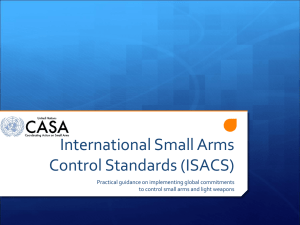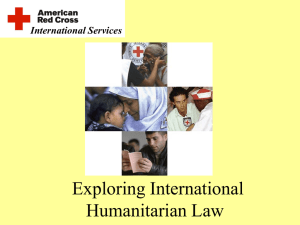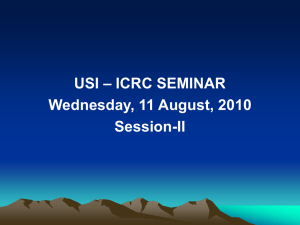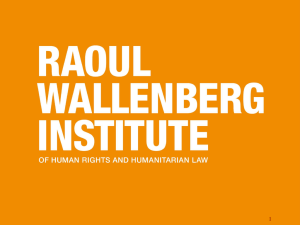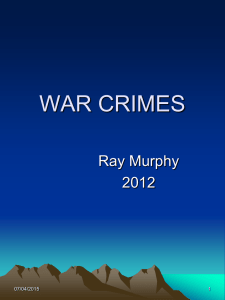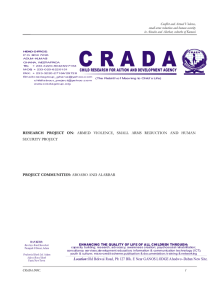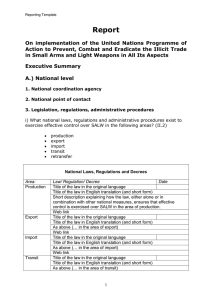Including-Small-Arms-in-the-ATT
advertisement
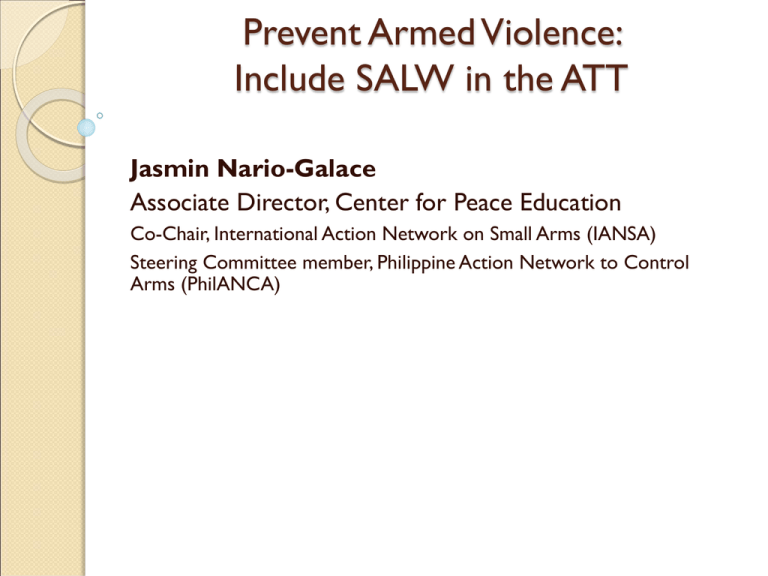
Prevent Armed Violence: Include SALW in the ATT Jasmin Nario-Galace Associate Director, Center for Peace Education Co-Chair, International Action Network on Small Arms (IANSA) Steering Committee member, Philippine Action Network to Control Arms (PhilANCA) What is SALW? Small arms include “revolvers and selfloading pistols, rifles and carbines, assault rifles, submachine guns and light machine guns” Light weapons include “heavy machine guns, hand-held under-barrel and mounted grenade launchers, portable anti-tank and anti-aircraft missile systems, mortars of less than 100mm caliber” Why are SALWs widely used? Easy to use Inexpensive Abundant Easily available Durable Why are SALWs a concern? a. The widespread availability is a contributing factor to : the rates of injury and death ICRC reported that the vast majority of those killed or injured in armed conflicts have been the victims of assault rifles, grenades, mortars and other small arms. And they have all too often been used, not against soldiers in combat, but against civilians. Q:How many people are killed by SMALL arms? A. B. C. D. One person a day One person every hour One person every minute Ten people everyday Every year, throughout the world, more than half a million people are killed by small arms--that’s one person every minute (Small Arms Survey, 2001). Why are SALWs a Concern? SALW proliferation enables, intensifies and sustains armed conflicts “Most armed conflicts are fought primarily with SALW...and such are weapons of choice in civil wars and terrorism, organized crime and warfare”. -(Report of the UNSG to the SC on the subject of small arms (S/2008/258) Case in Point: The Philippines - The armed conflict between the government and the Communist Party of the Philippines- a conflict running for more than 40 years now -The armed battle between GRP and the MILF is more than 40 years old, as well Why are SALWs a Concern? “Arms purchases divert resources away from efforts to improve human development. Countries plagued by armed violence in situations of crime or conflict often perform poorly in terms of the MDGs. Moreover, armed violence forms a serious impediment to economic growth.” –UNSG Report to the SC on the subject of small arms (S/2008/258) -SALW proliferation impedes development or reverses development gains Loss of opportunities for direct foreign investment and local investment Tourism declines Difficulty in carrying out development programs SAs are often used as a tool of intimidation in pursuing “development” projects (e.g., dam building, logging, oil exploitation) Case in Point: Philippines is #136 in the Global Peace Index of 153 countries ranked- the proliferation of small arms was one of the reasons cited for such low ranking - SALWs play a role in the ability of armed groups to commit gross human rights abuses extra-judicial killings torture and other cruel treatments arbitrary arrests sexual violence enforced disappearances suppression of the right to peaceably assemble, opinion, to be elected in office, and to claim ownership of resources like land SALWs facilitate violations of international humanitarian law Some examples: -attacks on peacekeepers and humanitarian workers and hostage-taking violate the Geneva Conventions (ICRC workers kidnapped in Mindanao) -genocide or mass killings violate the Geneva Conventions -extensively destroying property not justified by military necessity violates Geneva Conventions -purposely directing attacks against civilians violates the Geneva Conventions -forcibly recruiting children to become combatants violates the Geneva Conventions Why the Concern about SALW? It is most often small arms and light weapons (SALW) that are used to facilitate and commit various forms of violence and crimes against women, both during and outside of armed conflict. These forms of violence violate international human rights law and international humanitarian law. Case in Point 64,000 women and girlswereestimated to have suffered war-related sexual violence in Sierra Leone’s civil war between 1991 and 2002. Testimonies of women explain how the assaults were endured at gunpoint. ´They put their guns to our throats and stomachs to make sure that we followed their orders,’ one woman reported Firearms in Focus 875 million guns in circulation worldwide 1,000 people daily killed by gunshots + 8,000,000 new guns /year - 800,000 destroyed /year Small Arms Survey, 2007 23% military 3% 74% police civilian (incl. security guards) Q: In recent years, 490,000 people have died from conflict-related and crimerelated armed violence, how much of this was perpetrated using firearms? A. 50% B. 70% C. 40% D. 60% Firearms in Focus An estimated 490,000 non-armed conflict killings have taken place in the world each year of which an average of 60%-roughly 300,000 annually-are estimated to have been perpetrated using firearms. Note: more gun facts can be found at gunpolicy.org with country to country comparison charts Source: IANSA and Amnesty International (2011). How an arms trade treaty can help prevent armed violence. INCLUDING SALW IN THE ATT The correlation between arms availability and armed violence and the uncontrolled proliferation of SALW as a key element in fuelling armed violence has time and again been noted. A way of addressing availability is to improve controls on the supply of these weapons including their import, export and international transfer. Including SALW in the scope of the ATT can contribute in reducing armed violence. Conclusion The ATT provides an opportunity to help reduce and prevent armed violence caused by SALW availability and proliferation. Member-States of the United Nations must seize this opportunity. Include SALW in the scope of the ATT! References IANSA and Amnesty International (2011). How an arms trade treaty can help prevent armed violence. SIPRI Yearbook 2011: Armaments, Disarmament and International Security

